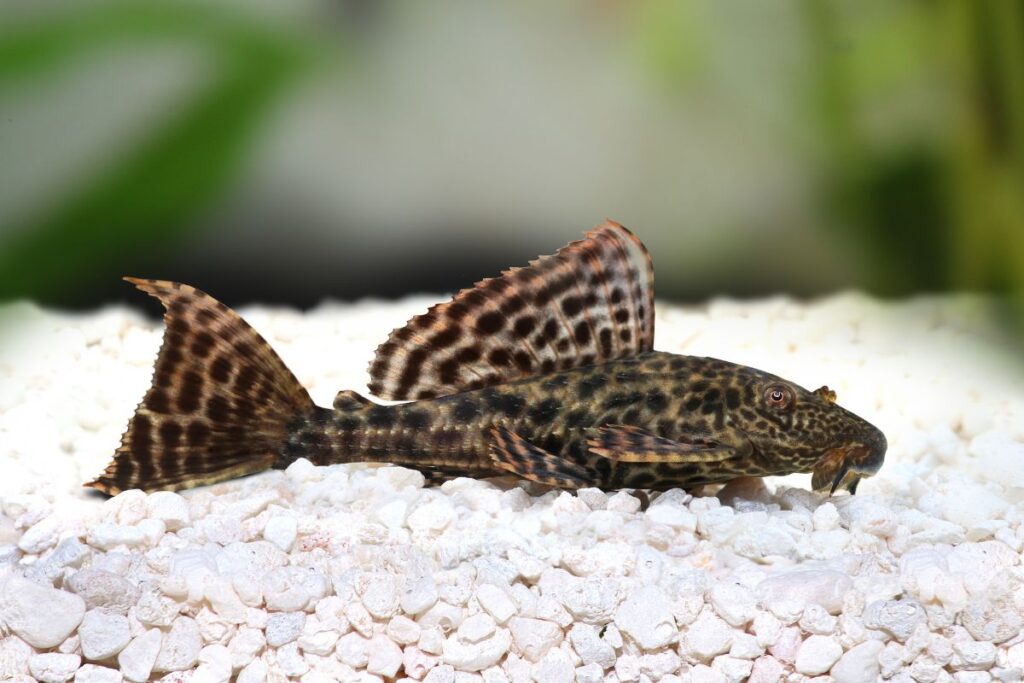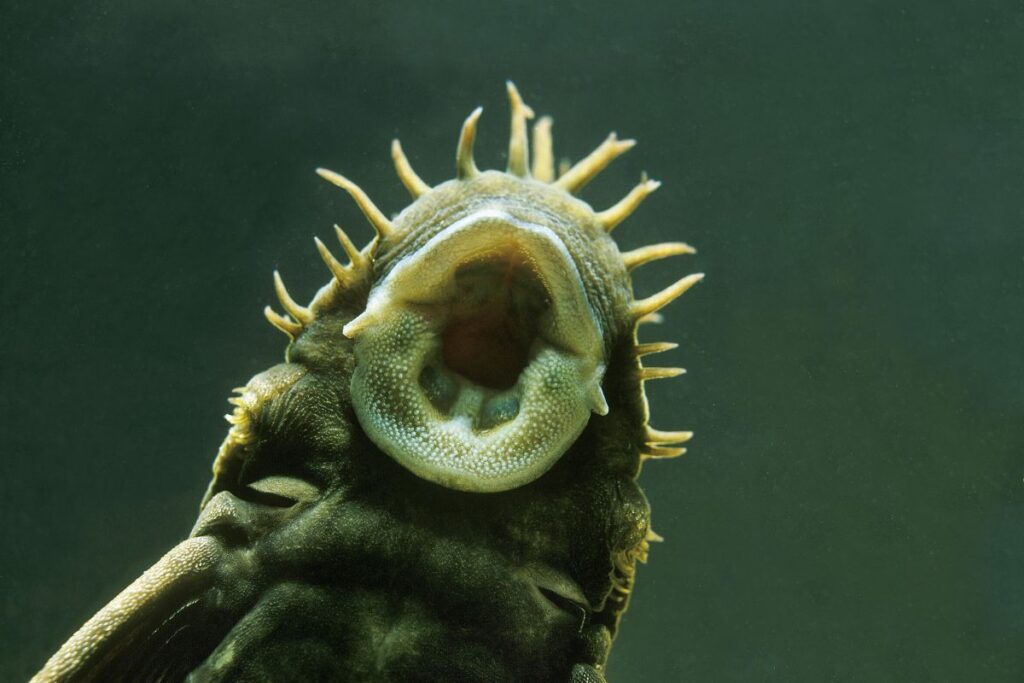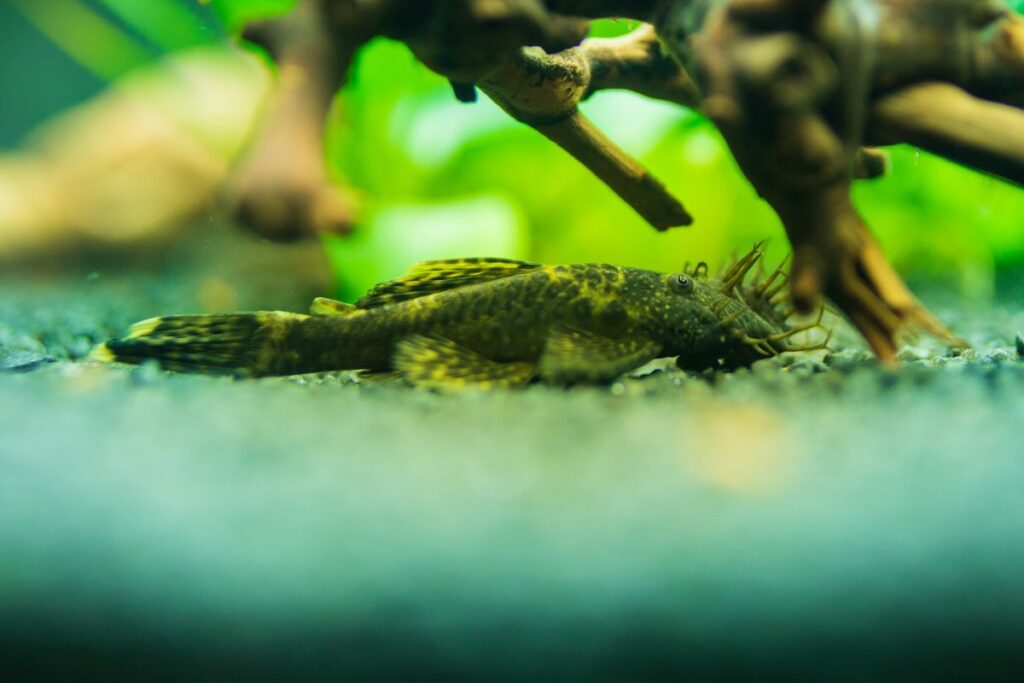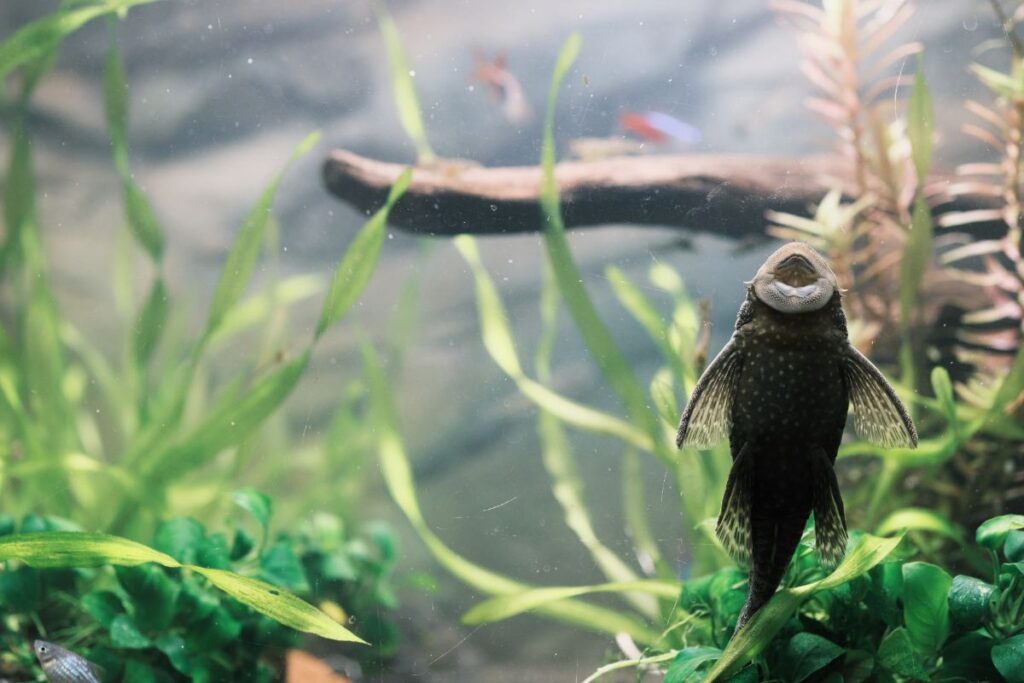Have you ever noticed your pleco changing color? I have, and it’s fascinating to watch! Plecos are known for their unique ability to change color, and it’s a topic that has intrigued fish enthusiasts for years. In this article, we’ll explore the reasons why plecos change color and what it means for their health.
Generally, plecos can change color depending on their mood, environment, and age. Some species of plecos also change color as they mature. Stress, illness, and poor water quality can also cause changes in color.
Many people believe that plecos change color to blend in with their surroundings, but this isn’t entirely true. While plecos can change color to match their environment, they also change color for other reasons.
For example, plecos may change color when they’re stressed or scared. They may also change color when they’re trying to attract a mate or establish dominance over other fish in the tank.
Understanding why plecos change color is important for their overall health and well-being. By learning to recognize the different colors and patterns that plecos display, you can better understand their behavior and take steps to ensure that they’re happy and healthy.
So, let’s dive into the world of pleco color changes and discover what makes these fish so unique!

Table of Contents
Plecos: An Overview
I have always been fascinated by plecos. These fish are known for their unique appearance and their ability to clean tanks by eating algae. But what makes plecos truly interesting is their ability to change color. In this article, we will explore the different types of plecos and what causes them to change color.
Plecos, also known as suckerfish, are a type of catfish that are native to South America. There are over 150 different species of plecos, each with its own unique appearance and behavior.
Some species are small and can be kept in a community tank, while others can grow up to 2 feet long and require a large aquarium.
One of the most interesting things about plecos is their ability to change color. While some species stay the same color throughout their lives, others can change depending on their environment, mood, or breeding season.
For example, the zebra pleco is known for its black and white stripes, but during breeding season, the males develop bright orange spots on their heads and fins.
Another factor that can affect a pleco’s color is stress. When plecos are stressed, they may become darker or lighter in color.
This can happen if they are kept in a tank that is too small or if they are not provided with enough hiding places. It is important to create a comfortable and stress-free environment for your plecos to ensure they stay healthy and happy.
In conclusion, plecos are fascinating fish with unique characteristics, including their ability to change color. By understanding the different types of plecos and what factors can affect their color, you can create a thriving environment for these amazing creatures.
Factors That Affect Pleco’s Color
As an aquarium enthusiast, I have learned that there are several factors that can affect the color of plecos. Here are some of the most important ones:
Diet

The diet of a pleco can significantly impact its color. Plecos are known to have a varied diet, and their color can change depending on what they eat.
For example, plecos that are fed with high-quality foods that contain a lot of protein, vitamins, and minerals tend to have a brighter and more vibrant color.
On the other hand, plecos that are fed with low-quality foods or a monotonous diet may become dull and lose their color over time.
Personally, I have noticed that my plecos tend to have a more vibrant color when I feed them with a varied diet that includes algae wafers, vegetables, and live foods like brine shrimp.
Lighting
Lighting is another factor that can affect the color of plecos. Adequate lighting is essential for the growth and development of algae, which is a vital part of a pleco’s diet. If a pleco is kept in a poorly lit aquarium, it may not get enough algae, which can cause it to lose its color.
Additionally, the color of a pleco can change depending on the type of lighting used in the aquarium. For example, plecos may appear darker under blue lighting, while they may appear lighter under white lighting.
Water Quality
Water quality is crucial for the health and well-being of plecos. Poor water quality can cause stress and illness, which can manifest in a loss of color.
Additionally, high levels of nitrates and other pollutants in the water can cause discoloration in plecos.
Personally, I have found that regular water changes and the use of a high-quality water conditioner can help maintain the color of my plecos.
Overall, it is essential to maintain a healthy and varied diet, adequate lighting, and good water quality to ensure that plecos maintain their vibrant colors.
Types of Plecos That Change Color
Common Pleco

The Common Pleco is one of the most popular types of plecos and can grow up to two feet long. They are known for their ability to change color, which is influenced by their environment and mood.
When they are stressed or scared, their color can darken to a deep brown or black. However, when they are happy and healthy, their color can range from a light yellow to a dark green.
When I first got my Common Pleco, I was amazed at how quickly it changed color. At first, it was a pale yellow, but after a few days in its new tank, it turned a vibrant green. I soon learned that this was a sign that my pleco was happy and healthy in its new home.
Bristlenose Pleco

The Bristlenose Pleco is a smaller species of pleco that is known for its bristly appearance.
They are also known for their ability to change color, which can range from a light brown to a dark black. When they are happy and healthy, their color can be a bright yellow or orange.
One of the most interesting things about Bristlenose Plecos is that they can change color to blend in with their surroundings. This is a survival mechanism that helps them avoid predators. For example, if they are in a tank with a lot of green plants, they may turn a darker green to blend in.
Rubber Lip Pleco
The Rubber Lip Pleco is a small, peaceful species of pleco that is known for its rubbery lips. They are also known for their ability to change color, which can range from a light brown to a dark black. When they are happy and healthy, their color can be a bright yellow or orange.
One of the most interesting things about Rubber Lip Plecos is that they can change color based on their mood. When they are stressed or scared, their color can darken to a deep brown or black. However, when they are happy and relaxed, their color can be a bright yellow or orange.
Overall, the ability of plecos to change color is a fascinating aspect of their behavior. By understanding the different types of plecos that can change color, you can better appreciate the unique beauty of these amazing fish.
Do All Plecos Change Color?
One of the most fascinating things about plecos is their ability to change color. However, not all plecos change color, and the extent of color change varies depending on the species.
In my experience as an aquarium enthusiast, I have observed that some plecos change color more dramatically than others.
For example, the bristlenose pleco (Ancistrus sp.) is known to change color from a dark brown to a light brown or even a yellowish color. On the other hand, the common pleco (Hypostomus plecostomus) may only exhibit a slight change in color, if any at all.
It is important to note that color change in plecos is not always a sign of good health. Stress, poor water conditions, and other factors can cause plecos to change color. Therefore, it is important to monitor your plecos closely and address any issues that may arise.
While not all plecos change color, it is still a fascinating aspect of these fish. If you are interested in owning a pleco that changes color, do your research and choose a species that is known for its vibrant coloration.
Why does my pleco look discolored?

Have you ever looked at your pleco and wondered why it looks discolored? As a fish owner, I have experienced this myself. It can be alarming, especially if you don’t know what’s causing it.
One reason why your pleco may look discolored is due to stress. Stress can cause a variety of physical changes in fish, including changes in color. If your pleco is stressed, it may appear pale or even white. This could be due to a number of factors, such as poor water quality, overcrowding, or a lack of hiding places.
Another reason why your pleco may look discolored is due to disease. There are several diseases that can cause changes in color, such as ich or velvet. If you notice that your pleco has a fuzzy or velvety appearance, it may be suffering from one of these diseases. In this case, it’s important to seek treatment from a veterinarian or aquatic specialist.
Finally, some plecos change color naturally as they mature. For example, some plecos may start out as a dark brown or black color, but as they get older, they may turn a lighter color or even develop spots. This is completely normal and nothing to worry about.
Overall, if you notice that your pleco looks discolored, it’s important to investigate the cause. Whether it’s due to stress, disease, or natural changes, it’s important to take action to ensure the health and well-being of your fish.
Personally, I once had a pleco that appeared pale and discolored. After doing some research, I realized that the water quality in my tank was poor. I immediately did a water change and added some hiding places for my pleco. Within a few days, my pleco’s color returned to normal and it was swimming happily once again.
How to Enhance Your Pleco’s Color
Proper Diet
One of the most important factors in enhancing your pleco’s color is providing a balanced and nutritious diet.
In the wild, plecos feed on algae and other plant matter, so it’s important to replicate this in their diet. You can feed your pleco a variety of vegetables such as zucchini, cucumber, and spinach, as well as algae wafers and pellets specifically designed for plecos.
I’ve found that incorporating a small amount of spirulina into my pleco’s diet has also helped to enhance its color. Spirulina is a type of blue-green algae that is rich in nutrients and can help boost your pleco’s immune system as well.
Ideal Lighting

Proper lighting is also important in enhancing your pleco’s color. Plecos are nocturnal fish, so they prefer dim lighting. However, they still require some light to maintain their color.
I recommend using a full-spectrum LED light that is specifically designed for aquariums. This will provide the necessary light for your pleco without being too bright or harsh.
It’s also important to provide a consistent light cycle for your pleco. Aim for 8-10 hours of light per day, and make sure to turn off the lights at night to give your pleco a chance to rest.
Maintaining Good Water Quality
Finally, maintaining good water quality is crucial in enhancing your pleco’s color. Plecos are sensitive to changes in water parameters, so it’s important to keep the water clean and well-maintained.
Make sure to perform regular water changes and use a high-quality water conditioner to remove any harmful chemicals or toxins from the water.
I’ve also found that adding driftwood to my pleco’s tank has helped to maintain good water quality. Driftwood contains natural tannins that can help to lower the pH of the water and prevent the growth of harmful bacteria.
By following these tips, you can help enhance your pleco’s color and keep it healthy and happy. Remember to provide a balanced diet, proper lighting, and maintain good water quality to ensure your pleco thrives in its environment.
Personally, I’ve noticed a significant improvement in my pleco’s color since incorporating spirulina into its diet and using a full-spectrum LED light. It’s amazing how small changes can make such a big difference in the appearance of your fish!
Recommended Products for this article:
- Hikari Algae Wafers – These algae wafers are a high-quality food source that can help enhance the color of plecos. They contain a variety of nutrients that can promote healthy growth and vibrant coloration.
- NICREW LED Aquarium Light – This full-spectrum LED light is specifically designed for aquariums and can provide the necessary light for your pleco without being too bright or harsh. It can help enhance the color of your pleco and promote healthy growth.
- Seachem Prime Water Conditioner – This high-quality water conditioner can help remove harmful chemicals and toxins from the water, ensuring that your pleco maintains its vibrant color. It can also help promote healthy water conditions and prevent stress and illness in your fish.
- Fluval Driftwood – This natural driftwood can help maintain good water quality and promote healthy growth in your pleco. It contains natural tannins that can help lower the pH of the water and prevent the growth of harmful bacteria.
Conclusion
After conducting extensive research and analysis, it is clear that plecos do change color based on various factors such as age, diet, and environment. While some species of plecos are known to change color more than others, it is important to note that not all plecos will exhibit color changes.
It is also important to keep in mind that color changes in plecos can be gradual and may not be immediately noticeable. Therefore, it is recommended to observe your plecos regularly to track any changes in color.
Overall, it is fascinating to learn about the various factors that can influence the color of plecos. As a personal anecdote, I once had a pleco that changed from a dull brown color to a vibrant orange after being introduced to a new diet consisting of fresh vegetables and fruits. It was truly a sight to behold!
While there is still much to be learned about plecos and their color-changing abilities, it is clear that these unique and fascinating fish are capable of adapting to their surroundings in remarkable ways.
“Learn how to keep your pleco healthy and happy with our Pleco Care 101 guide – the ultimate resource for all pleco owners!”
FAQs
Do plecos change color to camouflage?

Yes, plecos can change color to blend in with their surroundings. This is a common survival mechanism that helps them avoid predators. When plecos feel threatened or stressed, they can change their color to match the color of their environment. For example, if a pleco is in a tank with a dark substrate, it may become darker to blend in better.
What color is pleco?
Plecos come in a variety of colors, depending on the species. Some common colors include brown, black, green, and gray. Some plecos have spots or stripes, while others may have a solid color. The color of a pleco can also change depending on its environment or mood.
Can bristlenose plecos change color?
Yes, bristlenose plecos can change color. Like other plecos, they may change color to blend in with their environment or to express their mood. Bristlenose plecos are known for their distinctive bristles on their nose, which can also change color depending on the fish’s mood.
Can rubber lip plecos change color?
Yes, rubber lip plecos can change color. They are known for their ability to change from a dark brown to a light yellow or gray color. This change in color is often associated with their mood or level of stress.
Do clown plecos change color?
Yes, clown plecos can change color. They are known for their bright orange color, but they may become darker or lighter depending on their mood or environment. I once had a clown pleco that would become extremely dark when the lights were turned off in the tank. It was fascinating to watch!
Overall, plecos are fascinating fish with a variety of colors and behaviors. Whether they are changing color to blend in with their surroundings or to express their mood, plecos are sure to captivate any fish enthusiast.
Personally, I have always been fascinated by the ability of plecos to change color. Watching my clown pleco change from bright orange to almost black was always a highlight of my day. It’s amazing how these fish can adapt to their environment and express themselves in such unique ways.
Reference: Wikipedia.
